Korfball drills for technique attack / score
Inshort: practise all kinds of forms of the shot from a supporting position.
Organisation: pairs per basket, always one person under the basket and one person in front of it. Change after about 1 minute.
a ) One person in front of the basket at about 6 meters, the shooter stands under the basket. The shooter starts away from the basket (backwards), gets the ball and shoots immediately. The striker catches the ball.
b ) As exercise a., but the shooter only threatens with a shot, lets the defender jump in and then continues with an "underhand pull ball": a kind of private penalty throw from about 5 meters diagonally behind the basket. The Germa-ball - so called by me after Germa Woldhuis of Nic. who had success with this on a regular basis - is practised here. The server catches the ball.
c ) The starting situation is the same, but the shooter now gets a defender with him (some pairs cancel each other out). The defender's task is to decide which of the two possibilities (a. or b.) the attacker will get: either he reacts deliberately too late (after which a shot must follow), or he follows the shooter too closely (thus giving the opportunity for an underhand draw). In exercises d., e. and f., the attacker plays free with one simple movement. An efficient way, which requires however a lot of technique (and thus practice).
- Play freely but see practice back.
- 3 x interceptions change
- score interception off
- At each basket 3 attackers and 3 defenders
- Keep an ideal triangle
- You may only be out of square for 3 seconds
- Move inside every time
- Pressure
- Defenders run along
- Defenders use their arms
- Defenders full pressure
- Scoring change function
- Player 1 stands by the pawn
- Player 2 comes to offer next to player 1 and doubles once
- Player 2 then runs deep
- Player 1 goes after his own ball and makes a handover
- Player 2 takes a through ball
- Exchange after X chances
- Scoring a total of X goals
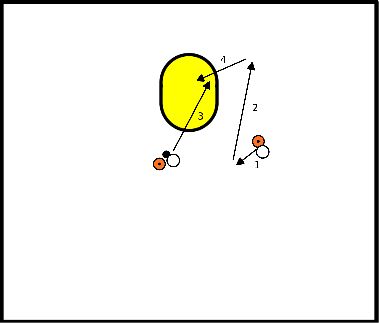
- Keeping space in the box, through running lines in a square
- Timely replenishment of vacant position, timing running moments.
- Passing ball at pace to next player.
- Player 1 plays to 2 -> runs after own ball at reasonable pace;
- Player 2 plays directly to 3 -> runs at reasonable pace after own ball;
- etc.
- The ball pace goes up slowly.
- When the children have this under control, the ball goes the other way.
Eventually, players should always be able to get to the empty spot just in time, because the pace of the ball is almost faster than that of the players.
Playing tight balls is a requirement here.
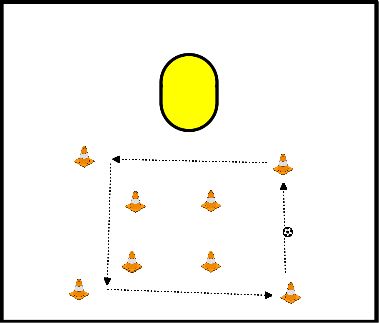
Step 1:
- Player Red defends Player Blue.
- Player Blue has the ball and then throws it to Player White and runs deep and shoots.
- Follow Step 1 and after Player Blue runs deep, Player White rushes in for a giveaway.
- Player Blue goes for a pass through Blue.
- Player Red continues to defend, but allows the through ball.
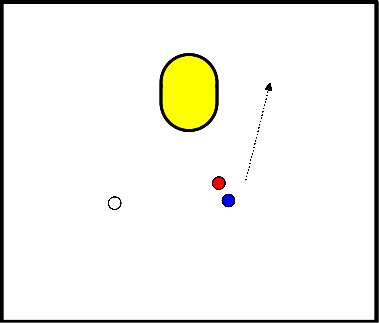
Minimum 3 groups of 2.
Maximum 5 groups of 3 or 4 groups of 4.
- Each group has a basket.
- Number of balls depends on how many groups. For example, 3 groups 2 balls.
- Make easier by fewer balls and larger groups.
- the back player cuts in to the support as the ball enters the field and gets it played.
- the passer simultaneously runs across the support to the rebound and takes over.
- the support passes the ball to the diagonal player in the break and takes the shot
- If that is not successful, the ball can be passed to the outgoing first rebounder
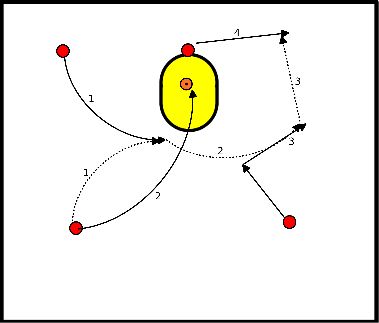
- The first ball is played deep from the front pocket.
- Then the other front comes in and passes the ball.
- The first passer runs across the block to the catch.
- The adjuster runs on the ball side for a through ball to the post.
Alternatively, the ball is played back directly for the distance shot. - The player under the post steps out as soon as the rebound is taken over from the front and ensures that the player with the ball has two points of attack.
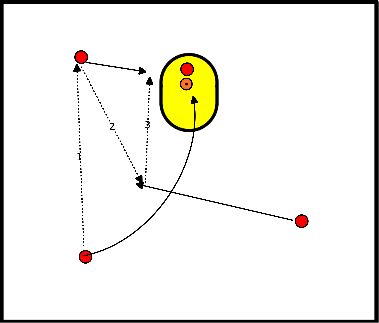
A small square around the basket. In this square, 2 players must continuously attack and pass. After each pass the player is in motion.
- 2 Run after passing. After 4 ball touches the shot follows and the other one catches it (shoot to score, not because you are free).
- 3 Crossing after passing.
- After each pass, the thrower crosses with the player who did not receive the ball and they swap positions. After crossing, the ball goes to one of the two and the other one catches it.
- 3/1 Same as above but make sure that, as soon as you receive the ball, you are ready to shoot. If you are in a good position and have caught the ball well, you may shoot, otherwise you play on and the next player shoots.
- 4 All of the above actions but now with a good rebound, but this one does not stay in position.
6 at the basket:
- Defenders give pressure, but allow the shot.
- By moving and playing together as close to the basket as possible, the players create a good opportunity.
- Rotation is done when: a goal is scored or the defender has the ball.
Change positions after 2 attacks, any other players take penalties on another post. Then swap often.
Adjust:
- Move well after passing, free movement prevails over rebound --> dynamic
- Turn in time for the shot.
- Emphasize that every pass should result in an opportunity, so no pointless doubling.
- Shoot to score, do not throw to throw
- Prepare good shots, also close to the basket (do not take short chances nonchalantly).
After a while, make it more difficult:
- After each pass you must cross with the other player who is not in possession of the ball.
- Afterwards, you can leave the crossing out, and give the opportunity to run in support from the space.
5 players at the basket:
- By moving and playing together as close to the basket as possible to get a good opportunity
- Rotation is done when: a goal is scored, the defender has the ball or when the ball bounces.
Move forward in sequence A-A-A-V-V. The remaining players take short chances at a different post. Alternate often.
Adjusting:
- Move well after passing, free movement prevails over rebound --> dynamic
- Turn in time before shooting
- Shoot to score, do not throw to throw
- Finish your shot preparations well, also close to the basket (do not take short chances).
After a while, make it more difficult:
- After each pass you must cross with the other player who is not in possession of the ball







